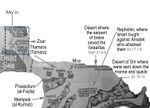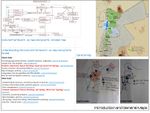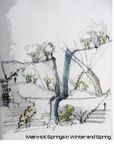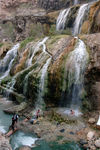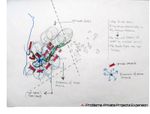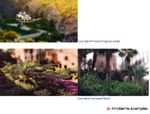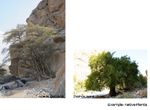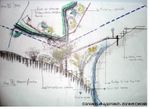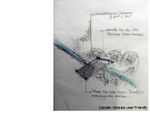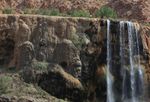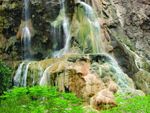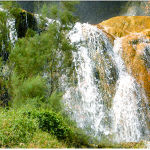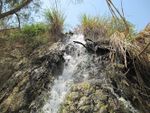Planting Design 2013 Working Group 9 - Case Study B
---> back to group page working group 9
'Ma'in Hot Springs حمامات ماعين'
Rationale: 'Why is this case interesting?'
'Hamammat Ma'in "Ma'in Hot Springs, حمامات ماعين , Zarka Ma'in" are hot mineralized-fresh-springs that lies 264 meters below sea level. Ma'in is located in the city of Madaba '58 Kms away from the city of Amman'. Ma'in springs feed the Dead Sea and located on the edge of sub-springs.'
- 'Why did you select it?'
'The German explorer Ulrich Jasper Seetzen(1767-1811) wrote after his visit to the hot springs of Ma’in in 1807;”in dem Wasser wuchs eine gruene schleimige Conferve” in the water grew a green slimy microscopic alga” The Ma’in springs consist of a large number of natural orifices, outflow channels and waterfalls. I choose Ma’in springs as a case due to many reasons, first for the remote location in the lowest point in the world, 2nd due to the springs connection with other sub-springs and the Dead-Sea on the edge of the west border of Jordan. 3rd, for a country as Jordan with very less natural resources, the site works as an attraction tourism center for both locals and tourists alike. The mineral-rich waters of these hyper-thermal waterfalls originate from winter rainfalls in the highland plains of Jordan and eventually feed the 109 hot and cold springs in the valley. This water is heated to temperatures of up to 63° Celsius by underground lava fissures as it makes its way through the valley before emptying into the Zarqa River.'
- Is it exemplary for a specific theme or a problem?Yes, it's an exemplary for nature redevelopment, management and conservation under strategies of environmental planning.'
- 'In how far does it relate to your life?'
According to the physical location, it does not relate to people life in crowded cities. However, the vibrant space of Ma'in shapes the perceptual connection for habitants since cities of Jordan as "Amman" lack natural green spaces. For many users it would be the required place for meditation, medication, public space. For me, the natural network that changes landscape dramatically as the slope goes down. The network, which locates in the west Jordanian border, connects Ma'in to other sub-springs and to the lowest point (Dead Sea). '
Author's perspective
'From which professional background/perspective are your documenting this case'? 'As student who comes from Jordan, the third driest country in the world with the minimum level of green cover. I'm trying to highlight the potentials of one of the most interesting sites in Jordan. "The hot springs of Ma’in". They have an importance in terms of economic, medication and natural aspects. In economic aspects they are an important tourist site in the area of the Dead Sea and often used by tourist as a destination for a day trip. In terms of the medication the site works as a recreational zone due to its hot water springs. The unique natural aspect of the site is that it has the characteristics of an oasis in a very dry and unique landscape, but the distinctive feature of the hot springs. With the architecture background and the understanding of the urban and landscape layers I will try to highlight the current main problems the site has, as well my design vision for protecting, enhancing and connecting the hot springs and the surrounding area.'
Landscape and/or urban context of your case
- 'On the east bank of the Dead Sea two locations with thermal springs were famous in antiquity: Kallirrhoe and Baarou or Baaras. The springs were praised by Roman and Jewish historians for their curative properties and the sweetness of their waters. Josephus (Jewish War I, 657-659; Antiquities XVII, 169-176) describes the visit of King Herod the Great to the hot springs of Baarou (Ma'in), just before his death in 4 BC. The king "crossed the Jordan to take the warm baths at Baarou, the waters of which descend into the lake Asphaltitis and from their sweetness are also used for drink"
- The hot springs of Baarou are placed on the Madaba Map slightly northeast of the Baths of Kallirrhoe. The label [BA]AROU runs across a stream, flowing down from the mountains to the sea, originating as it seems just behind the inscription. This position corresponds to the hot springs of Hammamat Ma'in, the sources which provide most of the waters of the stream. Although the first two letters of the inscription are missing - it can be identified with the ancient name of Baarou, a small river refered to by Eusebius in connection with a very large village [Beelmeon] "near the hot springs of Baras in Arabia" Josephus describes the place called Baarou or Baaras: "In the ravine [Wadi Zarqa Ma'in] which encloses the town on the north [Machaerus], there is a place called Baaras, which produces a root bearing the same name". After describing the mysterious properties of the plant he continues: "In this same region flows hot springs, in taste widely differing from each other, some being bitter, while others have no lack of sweetness. Many springs of cold water also gush up". At the end he mentions a cave screened by a projecting rock, from which on one side extremely cold water runs down and on the other extremely hot water. This description clearly refers to the hot springs of Hammamat Ma'in, situated in the narrow and fissured Wadi Zarqa Ma'in about 4 km inland. Until the discovery of the Madaba map many scholars regarded the themes of Zarqa Ma'in as identical with the Baths of Kallirrhoe. However, Josephus did not mention "Kallirrhoe", but used the term Baarou. Moreover, its waters do not flow directly into the lake Asphaltitis, but form a river that descends into the sea.
- The deep wadi is enclosed from all sides by high cliffs, the air filled with the steam of the very hot water, which not only gushes up from the ground, but also pours down in hot waterfalls and a series of lower cascades". Josephus also mentions the cave, where the two water sources, one very hot and the other cold, run into a sort of bath-like pool.
- According to that account, there were no houses built in the middle of the valley, but mere reed huts. These were used during the winter time, the only period when the baths could be used without discomfort, due to the extreme heat and the flies prevalent during the other seasons.
Analytical drawings
'As the hot springs of Ma'in are playing a very significant natural dynamic space, the cultural impact could be both positive and negative. Local habitats are living there with the normal use of the natural resources. Ma'in district built of vernacular materials and the use of the space is sustainable. But as the population percentage increase, with a county with limited resources. Ma'in shapes a very important point in the economic situation and tourism. The types of the new buildings that imposing into the space and consuming by new construction the natural cover.'
- natural dynamic versus cultural framework - in how far do these two forces come together in your case?
- dynamic through the year (you may imagine how the site looks in spring and summer, maybe you also remember it)
- highlight potentials and problems
- Analytical Drawings
Projective drawings
- Please add four projective sketches/drawings (or montages/schemes) for your case and take the following aspects into account:
- How would you like this case to change in the near future? (in 1-2 years)
- And how could it look like in 10-15 years?
- Projective Drawings
Summary and conclusion
'The analysis shows that the Ma’in Hot springs faces serious threats regarding its natural potential. Especially the danger of further privatizing of the space and the use of non-endemic plants is a threat. As my concept shows, the answer to this threat could be to enhance the accessibility of the whole site with additionally structures like pedestrian bridges, as well as fostering the natural flora and fauna. With this interventions the Ma’in Hot spring can work in the future as a recreational and touristic spot for Jordanians as well as for foreign visitors.'
Image Gallery
You may add a series of images/photos in addition to the sketches/drawings
- Image Gallery
References
http://www.christusrex.org/www1/ofm/mad/articles/ClamerKallirhoe.html#Clamanchor40040919
http://www.wafainfo.ps/atemplate.aspx?id=8131
http://tu-freiberg.de/fakult3/geo/fog/fog_vol_16.pdf
About categories: You can add more categories with this tag: "", add your categories

